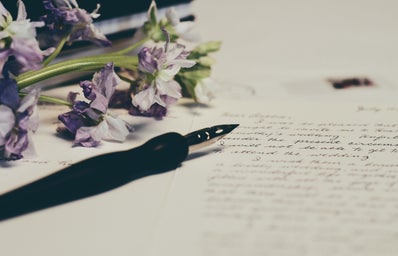It was a surprising discovery for me when I realized that my handwriting calligraphy was a less embellished version of the Spencerian script. It’s an American style developed by Platt Rogers Spencer in the 18th century. Back then, neat and legible penmanship was crucial for anyone entering business or education during the 19th century. In fact, employees could be turned away from a job if their handwriting was poor. It made me even more proud to know that I had mastered the art of writing in cursive.
While I didn’t attend the hand lettering workshop at the AIGA Design conference, looking at the work sparked inspiration and reminded me that calligraphy was a part of my childhood. I vividly remember my first time practicing the italic style, which was quite challenging. However, I persevered and practiced patiently.
It was a style I had practiced since I was six years old. In Vietnam, where I come from, legible handwriting is also highly valued, especially by Asian parents who are strict about grades, discipline, and academic activities. So my mom was serious about ensuring that I would practice calligraphy and even took me to handwriting courses on weekends to improve my skills. Back then, I didn’t think much about why we practiced this style but focused on perfecting my technique. We would practice different styles and sizes of letters for an hour and a half, starting with a large-size script and moving on to a smaller-size script with an italic style. The more I practiced, the better I became, and it helped me maintain the same technique even when writing fast.
Also, calligraphy is still a staple of our primary education. The emphasis on good handwriting was so great that it had become one of the subjects that were taken very seriously. Handwriting classes are compulsory for all elementary school levels; even the teachers are expected to have excellent penmanship. It was one of the subjects taken very seriously from first to fourth grade. Students are expected to develop the physical skill needed for handwriting, such as proper sitting posture, pencil grip, and forming lowercase and capital letters. There are specific rules and comments when grading assignments, and schools with competitions are held to reward those who demonstrate exquisite skill in italic and creative styles.
Calligraphy might seem like just pretty writing or fancy lettering, but the practice and the learning time are more than that. You are bound to encounter problems and mistakes when writing things by hand. It is more complicated than just hitting ctrl+z; once you write something, there is no way to go back. That’s why when I was in elementary school, my teachers noticed mistakes made; your grades would also depend on the cleanliness and perfection of your writing paper.
I now value the significance of this meditated practice, particularly in an age where typing dominates written communication. Even my professor, Karen Gutowsky-Zimmerman, said that only a few schools in the U.S. still promote writing in cursive. Surprisingly, my hometown, Vietnam, carries such a fascinating Western cultural tradition back to the 19th century and values its nostalgia. The art of handwriting and calligraphy is still a staple of our primary education, and I’m so happy that my hometown continues to encourage this low-tech practice. However, I believe we should also teach students why we write in this style and its history, which I did not learn when I was a child. Practicing calligraphy is also a form of meditation and relaxation, allowing me to concentrate and build my patience. Studies show that writing things out or manipulating problems with our hands can lead to better results. Whenever we encounter an issue, the act of writing can aid in the critical thinking process. This is why some people prefer to write physical journals to sort through complex emotions, better understand their situation, and discover potential solutions to their problems.
I think calligraphy is a gorgeous writing style that challenges us to improve our handwriting skills. I highly recommend learning calligraphy and experiencing the therapeutic effect of pen and paper!


